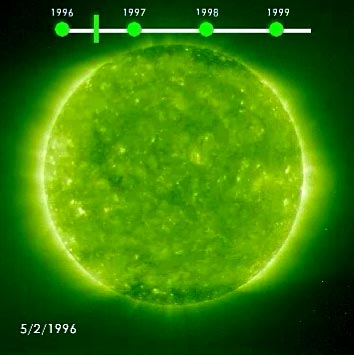 |
| This
movie demonstrates the increase in solar
activity from 1996-99. The images we're
taken by the SOHO spacecraft.
(Click
to launch movie.)
|
|
|
In the mid-1800s astronomers discovered
from thousands of sunspot sightings that, when they tabulated
and graphed them, their numbers increased and decreased over
time in a repeatable cycle. These extremes represent the amplitude
of the cycle. We now call this the solar activity cycle or
the sunspot cycle.
Solar Maxium (and minimum)
During the last 200 years, the time
between years of maximum activity, which is called the period
of the cycle, has been about 11 years, but sunspot cycles
can be as short as 9 or as long as 15 years. During sunspot
minimum conditions, such as the year 1996, astronomers counted
fewer than 5 sunspots on the surface of the Sun at any one
time. During sunspot maximum conditions in 2000, as many as
246 sunspots could be seen. On March 31, 2001, one very large
sunspot group was visible to the naked eye with the proper
safety precautions. (You should never look directly at the
Sun without proper shielding to avoid eye damage!).
Variations in the Cycle
Ancient Chinese astronomers also
kept track of naked-eye sunspots 4000 years ago, and that's
how we know that sunspots have been a common feature of the
Sun for millennia. We also know from graphs of the sunspot
cycle that sometimes the Sun just stops making them altogether.
This happened in the 1600s, and this was also the time when
Europe was in the grip of what they called a mini-Ice Age.
The Solar Cycle and Weather
Scientists don't fully understand
the connection between the sunspot cycle and weather conditions
here on Earth, but there does seem to be something going on
between them. Scientists have detected correlations between
the ups and downs of the solar activity cycle and the behavior
of a number of terrestrial atmospheric and climate systems.
For example, the ozone hole over Antarctica has an area that
appears slightly larger during sunspot maximum than sunspot
minimum. Traces of the 11-year cycle have also been claimed
to exist in ocean surface temperatures, coral reef layering
and the sizes of northern hemisphere storm systems.
 Find
out more about the Sun-Earth Connection at the Sun-Earth
Connection Education Forum Web site.
Find
out more about the Sun-Earth Connection at the Sun-Earth
Connection Education Forum Web site.
Text adapted from the
Sun-Earth Connection Tutorial courtesy of NASA, originally
written by Dr. Sten Odenwald. Images and videos courtesy of
NASA unless otherwised noted.
|